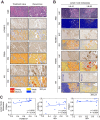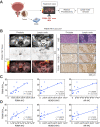Prostate-Specific Membrane Antigen-Targeted Imaging and Its Correlation with HOXB13 Expression
- PMID: 38936974
- PMCID: PMC11294063
- DOI: 10.2967/jnumed.123.267301
Prostate-Specific Membrane Antigen-Targeted Imaging and Its Correlation with HOXB13 Expression
Abstract
Homeobox 13 (HOXB13) is an oncogenic transcription factor that directly regulates expression of folate hydrolase 1, which encodes prostate-specific membrane antigen (PSMA). HOXB13 is expressed in primary and metastatic prostate cancers (PCs) and promotes androgen-independent PC growth. Since HOXB13 promotes resistance to androgen receptor (AR)-targeted therapies and regulates the expression of folate hydrolase 1, we investigated whether SUVs on PSMA PET would correlate with HOXB13 expression. Methods: We analyzed 2 independent PC patient cohorts who underwent PSMA PET/CT for initial staging or for biochemical recurrence. In the discovery cohort, we examined the relationship between HOXB13, PSMA, and AR messenger RNA (mRNA) expression in prostate biopsy specimens from 179 patients who underwent PSMA PET/CT with 18F-piflufolastat. In the validation cohort, we confirmed the relationship between HOXB13, PSMA, and AR by comparing protein expression in prostatectomy and lymph node (LN) sections from 19 patients enrolled in 18F-rhPSMA-7.3 PET clinical trials. Correlation and association analyses were also used to confirm the relationship between the markers, LN positivity, and PSMA PET SUVs. Results: We observed a significant correlation between PSMA and HOXB13 mRNA (P < 0.01). The association between HOXB13 and 18F-piflufolastat SUVs was also significant (SUVmax, P = 0.0005; SUVpeak, P = 0.0006). Likewise, the PSMA SUVmax was significantly associated with the expression of HOXB13 protein in the 18F-rhPSMA-7.3 PET cohort (P = 0.008). Treatment-naïve patients with LN metastases demonstrated elevated HOXB13 and PSMA levels in their tumors as well as higher PSMA tracer uptake and low AR expression. Conclusion: Our findings demonstrate that HOXB13 correlates with PSMA expression and PSMA PET SUVs at the mRNA and protein levels. Our study suggests that the PSMA PET findings may reflect oncogenic HOXB13 transcriptional activity in PC, thus potentially serving as an imaging biomarker for more aggressive disease.
Keywords: HOXB13; PSMA; PSMA PET; androgen receptor; metastasis; prostate cancer.
© 2024 by the Society of Nuclear Medicine and Molecular Imaging.
Figures






Similar articles
-
Multicenter External Validation and Optimization of a Proposed Nomogram for Prostate-Specific Membrane Antigen PET/CT Accuracy in Biochemical Recurrence.Prostate. 2025 Aug;85(11):1016-1023. doi: 10.1002/pros.24910. Epub 2025 May 6. Prostate. 2025. PMID: 40329523
-
The Role of Prostate-specific Membrane Antigen Positron Emission Tomography for Assessment of Local Recurrence and Distant Metastases in Patients with Biochemical Recurrence of Prostate Cancer After Definitive Treatment: A Systematic Review and Meta-analysis.Eur Urol. 2025 Aug;88(2):129-141. doi: 10.1016/j.eururo.2025.05.006. Epub 2025 May 19. Eur Urol. 2025. PMID: 40393864 Review.
-
PSMA-PET-derived distance features as biomarkers for predicting outcomes in primary prostate cancer post-radical prostatectomy.Cancer Imaging. 2025 Jul 22;25(1):93. doi: 10.1186/s40644-025-00907-8. Cancer Imaging. 2025. PMID: 40696478 Free PMC article.
-
FAP and PSMA Expression by Immunohistochemistry and PET Imaging in Castration-Resistant Prostate Cancer: A Translational Pilot Study.J Nucl Med. 2024 Dec 3;65(12):1952-1958. doi: 10.2967/jnumed.124.268037. J Nucl Med. 2024. PMID: 39477498 Free PMC article.
-
The role of 68Ga-PSMA PET/CT scan in biochemical recurrence after primary treatment for prostate cancer: a systematic review of the literature.Minerva Urol Nefrol. 2018 Oct;70(5):462-478. doi: 10.23736/S0393-2249.18.03081-3. Epub 2018 Apr 17. Minerva Urol Nefrol. 2018. PMID: 29664244
References
MeSH terms
Substances
Grants and funding
LinkOut - more resources
Full Text Sources
Medical
Research Materials
Miscellaneous
